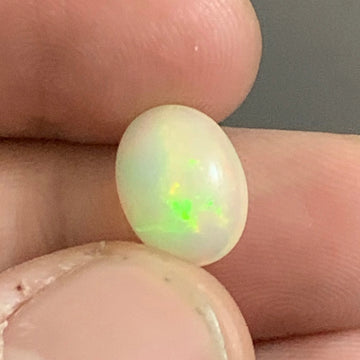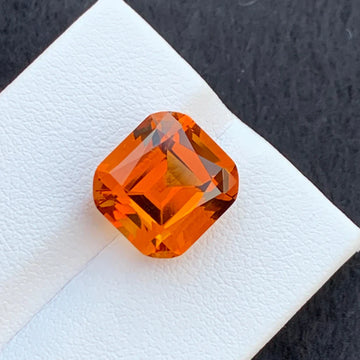
Discover the captivating allure of opal stone, a gem that bewitches with its kaleidoscope of colors. This enchanting gemstone, with its unique play-of-color, has been revered throughout history for its mesmerizing beauty and mysterious properties.
Opal Stone: A Mesmerizing Gem of Ever-Changing Beauty
Opal's breathtaking display of vibrant hues is a result of its internal structure diffracting light, showcasing a stunning array of iridescent colors that dance and shimmer with movement. From fiery reds and oranges to soothing blues and greens, opal stones offer an ever-changing visual feast that is truly one-of-a-kind.
Besides its captivating appearance, opal is believed to possess symbolic meanings and mystical powers. Throughout various cultures, it has been associated with love, passion, creativity, and inspiration. Some consider opal to bring good luck and enhance intuition, while others see it as a symbol of hope and renewal.
Opal comes in different varieties, including precious opal, fire opal, and common opal, each with its own distinct characteristics. Precious opal, known for its remarkable play-of-color, is highly prized and often used in jewelry. Fire opal, with its warm and fiery hues, exudes a unique charm, while common opal showcases a variety of colors without the play-of-color effect.
Whether you're drawn to opal for its striking aesthetics or its perceived metaphysical properties, this gemstone is a true testament to nature's artistic prowess. Adorning yourself with opal jewelry or gazing into the depths of an opal's iridescence is an experience that invites wonder and awe, making opal a gemstone that captures the imagination and leaves a lasting impression.

What is Opal Stone?
Opal stone is a type of mineral composed primarily of hydrated silica, with a unique internal structure that diffracts light, resulting in a play-of-color effect. It is classified as a mineraloid rather than a mineral due to its amorphous structure. Opal is formed through a process where silica-rich water seeps into cracks and voids in rocks, eventually solidifying and forming the gemstone.
Opal is renowned for its striking display of iridescent colors, which can include hues such as red, orange, yellow, green, blue, and purple. This phenomenon, known as play-of-color, occurs due to the diffraction and interference of light as it passes through the microscopic spheres or layers of silica within the stone. The patterns and intensity of the play-of-color vary from opal to opal, making each stone unique and captivating.
Opals are found in various locations worldwide, with notable sources including Australia, Ethiopia, Mexico, Brazil, and the United States. Australia, in particular, is known for producing some of the finest and most valuable opals, including the highly coveted black opals.
Opal is a popular gemstone used in jewelry, including rings, earrings, necklaces, and bracelets. Due to its delicate nature, opal requires careful handling and protection from heat and extreme temperature changes to prevent cracking or drying out.
Beyond its aesthetic appeal, opal has been associated with different symbolic meanings and beliefs throughout history. It has been regarded as a stone of inspiration, creativity, and emotional healing. Opal is also often linked to love, passion, and intuition in various cultural and metaphysical beliefs.
Overall, opal stone is a captivating gemstone admired for its mesmerizing play-of-color and unique beauty, making it a sought-after choice for jewelry enthusiasts and gemstone collectors alike.
How Is Opal Stone Formed?
Opal stone is formed through a process involving water and silica-rich materials. Here's a step-by-step explanation of how opal is created:
Geological Setting:
Opal formation typically occurs in areas where there has been volcanic activity or in sedimentary environments. These regions contain deposits of silica-rich materials, such as volcanic ash or silica gel.
Water Seepage:
Over time, water, often containing dissolved silica, seeps into cracks, voids, or porous rocks in the earth's crust. This can happen through rainfall, underground springs, or other water sources.
Silica Deposition:
As the water containing dissolved silica infiltrates the rock formations, it begins to deposit the silica in the open spaces within the rocks. This process may take thousands of years.
Solidification:
Gradually, the silica deposits solidify and form a solid gel-like substance, which is the initial stage of opal formation. The silica spheres or layers within this gel-like substance are what give opal its unique internal structure.
Play-of-Color Formation:
As the silica solidifies further, it forms a three-dimensional framework of closely packed spheres or layers. These spheres or layers diffract light that passes through them, resulting in the captivating play-of-color effect that opal is famous for.
Water Loss and Hardening:
Over time, the opal undergoes a process called dehydration, during which it loses water and hardens. This process can take millions of years and may be influenced by factors such as temperature and geological conditions.
The specific conditions and geological factors present during the formation process contribute to the different types and varieties of opal, such as precious opal, fire opal, and common opal. The color patterns, intensity of play-of-color, and transparency of the opal also vary depending on the specific geological conditions and the arrangement of the silica spheres or layers within the stone.
It's important to note that opal is a relatively delicate gemstone compared to others, and it can be sensitive to factors such as heat, rapid temperature changes, and rough handling. Proper care and protection are necessary to preserve the beauty and integrity of opal jewelry and specimens.

What Are The Properties Of Opal Gems?
Opal gems possess several distinctive properties that contribute to their unique beauty and value. Here are the key properties of opal:
Play-of-Color:
Opal is renowned for its play-of-color, an optical phenomenon where vibrant flashes of spectral colors are observed when light interacts with the internal structure of the gemstone. This captivating display is caused by the diffraction and interference of light as it passes through the silica spheres or layers within the opal. The play-of-color can include a wide range of hues, such as red, orange, yellow, green, blue, and purple. The patterns, intensity, and distribution of the colors vary from opal to opal, making each gemstone truly unique.
Body Color:
Apart from the play-of-color, opal gems also have a body color, which is the dominant base color of the stone. It can range from transparent, white, and gray to various shades of brown, black, and even rare colors like pink and blue. The body color can influence the overall appearance and value of the opal.
Transparency:
Opal gems can exhibit a wide range of transparency, from transparent to translucent and opaque. Transparent opals are highly valued due to their ability to display vibrant play-of-color with greater clarity. Translucent and opaque opals, while still displaying play-of-color, may have a slightly muted appearance.
Hardness:
On the Mohs scale of mineral hardness, opal typically ranges from 5.5 to 6.5. This makes opal a relatively soft gemstone compared to other popular gemstones. Its softness can make it more prone to scratching and damage, requiring careful handling and protection.
Specific Gravity:
The specific gravity of opal usually ranges between 1.98 and 2.20. This property helps distinguish opal from other gemstones when conducting density tests.
Luster: Opal exhibits a vitreous (glass-like) to subvitreous luster when properly polished. The luster enhances the gem's overall brilliance and appeal.
Fracture and Cleavage:
Opal has a conchoidal fracture, meaning it breaks with smooth, curved surfaces similar to glass. It does not possess cleavage planes, which makes it more challenging to cut and shape without risking breakage.
Size and Carat Weight:
Opals can vary in size and carat weight, ranging from small gemstones used in delicate jewelry to larger specimens that showcase the play-of-color more prominently.
It's important to note that opals are delicate gemstones and require proper care to prevent damage. They can be sensitive to factors such as heat, extreme temperature changes, chemicals, and rough handling. Regular cleaning and protection from potential hazards are essential to preserve the opal's beauty and durability over time.
What Does Opal Mean Spiritually?
Opal has been associated with various spiritual and metaphysical meanings throughout history and across different cultures. Here are some common spiritual interpretations and beliefs associated with opal:
Inspiration and Creativity:
Opal is often seen as a stone that inspires creativity and stimulates imagination. It is believed to enhance artistic expression and encourage originality in one's thoughts and ideas. Opal's vibrant play-of-color is thought to ignite inspiration and unlock creative potential.
Emotional Healing and Balance:
Opal is believed to have a soothing and calming energy that aids in emotional healing and balance. It is associated with promoting emotional well-being, harmony, and emotional stability. Opal is said to help release negative emotions, enhance positive feelings, and promote inner peace.
Intuition and Psychic Abilities:
Opal is often associated with enhancing intuition, psychic abilities, and spiritual insight. It is believed to heighten one's awareness and sensitivity to subtle energies, facilitating a deeper connection with the spiritual realm. Opal is sometimes used as a tool for meditation and spiritual exploration.
Love and Passion:
Opal has long been regarded as a stone of love and passion. It is associated with enhancing emotional bonds, attracting love, and strengthening relationships. Opal is believed to bring harmony and fidelity to partnerships and promote deep emotional connections.
Hope and Renewal:
Opal is seen as a symbol of hope and renewal. It is associated with new beginnings, fresh starts, and positive transformation. Opal's play-of-color is often interpreted as a representation of the ever-changing nature of life and the cycles of growth and renewal.
It's important to note that spiritual beliefs and interpretations can vary among individuals and cultures. The spiritual meanings attributed to opal are based on traditions, folklore, and metaphysical beliefs, and their significance may differ from person to person. Ultimately, the spiritual meaning of opal is a personal and subjective experience that can vary based on individual beliefs and connections with the stone.

Who Can Wear Opal Stone?
Opal stone is considered a gemstone that can be worn by individuals from various walks of life. However, there are some beliefs and considerations to keep in mind when it comes to wearing opal:
Birthstone:
Opal is the birthstone for the month of October. It is believed to bring good fortune and positive energies to individuals born in this month. As such, individuals born in October often have a special affinity for opal and may find it particularly meaningful to wear as a birthstone.
Astrological Significance:
Opal is associated with certain zodiac signs, particularly Libra (September 23 - October 22) and Scorpio (October 23 - November 21). It is believed to bring luck, balance, and emotional well-being to individuals born under these signs. However, it's important to note that not all astrological traditions assign opal as the birthstone for these signs, and astrological beliefs can vary across different cultures and systems.
Personal Attraction:
Opal's captivating play-of-color and unique beauty can attract individuals who are drawn to its mesmerizing appearance. People may choose to wear opal simply because they are personally attracted to its aesthetics and find joy in its vibrant hues.
Metaphysical Beliefs:
Some individuals believe in the metaphysical properties and spiritual meanings associated with opal, such as its ability to enhance creativity, intuition, and emotional well-being. Those who resonate with these beliefs may choose to wear opal as a means of accessing these qualities.
When considering wearing opal, it's important to remember that opals are relatively softer gemstones compared to others, and they require gentle care to prevent damage. Additionally, personal preferences and individual sensitivities may influence whether someone chooses to wear opal or any other gemstone. Ultimately, the decision to wear opal stone or any other gemstone is a personal choice based on individual taste, beliefs, and considerations.
Where To Buy Opal Gemstones Online?
There are several reputable online sources where you can buy opal gemstones. Here are some popular and trusted options:
Gemstone Retailers:
Many well-known gemstone retailers have online platforms where you can browse and purchase opal gemstones. Some reputable options include Gemstone Universe, OneStep Gems, and Rio Grande.
Online Marketplaces:
E-commerce platforms such as Etsy, eBay, and Amazon have a wide range of opal gemstones available from various sellers. When buying from these platforms, it's essential to check the seller's ratings, reviews, and return policies to ensure a positive purchasing experience.
Gemstone Auctions:
Online auction platforms like OneStep Gems and Gem Rock Auctions occasionally feature opal gemstones for sale. These auctions can provide an opportunity to find unique and high-quality opals, but it's important to research the seller and understand the auction process before participating.
Gemstone Associations and Forums:
Websites and online forums dedicated to gemstones, such as the International Opal Jewellers Association (IOJA) or gemstone enthusiast forums like GemologyOnline, often have sections where individuals can buy and sell gemstones, including opals. Engaging with knowledgeable gem enthusiasts and experts in these communities can provide valuable insights and access to reputable sellers.
When purchasing opal gemstones online, it's crucial to do your due diligence to ensure a reliable and trustworthy transaction. Consider the following tips:
Research the Seller:
Look for sellers with positive reviews, a solid reputation, and transparent information about their products and services. Check if they have any certifications or affiliations with recognized gemological organizations.
Gemstone Description and Images: Pay attention to detailed descriptions and high-quality images of the opal gemstone. This will help you assess its quality, including color, clarity, play-of-color, and any potential treatments or enhancements.
Certifications and Authenticity:
If possible, look for opals with certification from reputable gemological laboratories, such as the Gemological Institute of America (GIA) or the American Gemological Laboratories (AGL). Certifications provide additional assurance regarding the authenticity and quality of the gemstone.
Return Policy and Customer Support:
Review the seller's return policy, shipping options, and customer support services. It's essential to have recourse in case the purchased opal gemstone does not meet your expectations or arrives damaged.
Remember to set a budget and consider factors such as size, type of opal, and desired quality when searching for opal gemstones online. By exercising caution and conducting thorough research, you can find reputable online sources that offer genuine and high-quality opal gemstones.
Wrap Up
Opal stone is a mesmerizing gem known for its ever-changing beauty and play-of-color. It is formed through a process involving water seepage and silica deposition, resulting in a unique internal structure that diffracts light. Opal's properties include its vibrant play-of-color, body color, transparency, hardness, specific gravity, luster, and fracture. Spiritually, opal is associated with inspiration, creativity, emotional healing, intuition, love, passion, hope, and renewal.
Opal can be worn by anyone, particularly those born in October, individuals drawn to its aesthetics, and those who resonate with its metaphysical beliefs. When buying opal gemstones online, it's important to choose reputable sources, research sellers, review gemstone descriptions and images, consider certifications and authenticity, and be aware of return policies and customer support. By keeping these factors in mind, you can enjoy the captivating allure of opal stones in your jewelry or collection.



